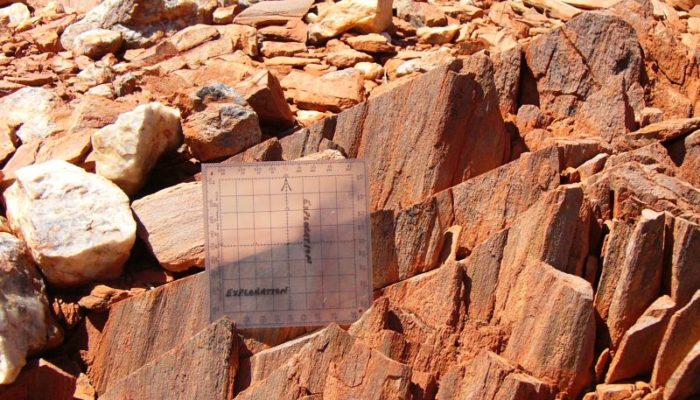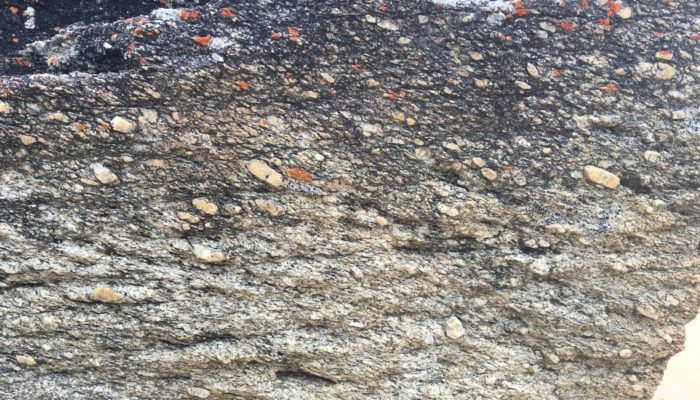Strike-slip faults by Arthur Sylvester (1988) is a must-read paper for anyone, and more so for those who want to understand the mechanisms of strike-slip faulting. Although it mostly refers to the San Andreas fault, the most studied strike-slip fault at the time (and possibly to date), the contribution is a comprehensive review of the state of the art about strike-slip faults in general. Sylvester ...[Read More]
TS Must-read – Dewey (1988) Extensional collapse of orogens
After building orogens with Dewey and Bird (1970) and extending them during building with Platt (1986), Dewey (1988) explores the lifetime of orogens in their last breath: their extensional collapse. Simple considerations on how to form a normally-thick continental crust (30-40 km) from a thickened continental domain (50-60 km) indicate that erosion of the topography alone is far from being suffic ...[Read More]
Features from the Field: Stretching Lineations

Deep beneath our feet, deformation of rocks at high temperature produces impressive structures such as shear zones, that localize the movement of two volumes of rock with respect to one another. Shear zones are strongly deformed bands with strongly foliated structures (i.e., with rocks that look like a pile of leaves) and kinematic indicators, such as S-C fabrics, that tell us geologists which way ...[Read More]
TS Must-Read – Molnar and Lyon-Caen (1988): Some simple physical aspects of the support, structure and evolution of mountain belts
In 1988 Peter Molnar and Hélène Lyon-Caen published their “Must-Read” paper on the support, structure and evolution of mountain belts. It is an article that touches on some core issues of plate tectonics by looking at two types of forces that resist mountain building, using key observations from Asian and American mountain chains. They name the first force “mechanical strength”, and to approximate ...[Read More]
Features from the Field: S-C fabrics
As we have seen in previous Features from the field posts, structural fabrics are both informative and spectacular. But many structural geologists will list a shear zone fabric, such as mylonite, as their favourite! As Samuele, Hannah and I wrote in a previous post, shear zones are regions of intense deformation where rocks have accommodated an extremely high amount of strain and that strain has b ...[Read More]
TS Must-Read – Platt (1986): Dynamics of orogenic wedges and the uplift of high-pressure metamorphic rocks
Orogens are the locus of intense deformation and metamorphism, mainly caused by convergent tectonics and burial. Yet, deeply buried rocks – metamorphosed at high pressure (HP) – are customarily met at the surface, even in “recent” systems such as the Alps. The long-standing question is naturally “how are these rocks brought back to the surface?” At the time John Platt wrote his manuscr ...[Read More]
Geology Bites Podcast
Podcast conversations about geology with researchers making key contributions to our understanding of the Earth and the Solar System I have always wanted to grasp the widest spatial and temporal context in which we find ourselves. After completing a physics degree at Cambridge University, this led me to cosmology, and a PhD on the structure of clusters of galaxies at Oxford University. I then join ...[Read More]
Run up to vEGU21: Advice for TS presenters and conveners
Abstracts, Displays and vPICOs: Upload, present and comment At vEGU21, three elements compound all presentations, known as vPICOs: the “Abstract”, the “Display material” and the “Live presentation slide”. Abstracts are the same as for in-person EGU General Assemblies. Each abstract submitted has received a DOI (Digital Object Identifier) to ensure the research i ...[Read More]
Run up to vEGU21: Advice for TS attendees
The program and general advice TS attendees can use their Personal Program to organise all sessions of interest, as in any EGU General Assembly. Entire sessions or individual abstracts can be added to keep track of your most important topics by clicking the yellow star next to the abstract or session. Aside from the regular sessions, there is also the usual range of Union Symposia and Great Debate ...[Read More]
The ECS TS team, or what happens between GAs
As the EGU Tectonics and Structural Geology (TS) Early Career Scientist (ECS) Representative, and with the outlook of a second virtual general assembly, I take the opportunity to: (i) provide in two following blogposts, some general guidelines and advice to EGU TS attendees, presenters, and conveners, as recently informed by several blog posts in the EGU-Wide blogs, and (ii) highlight some of the ...[Read More]




